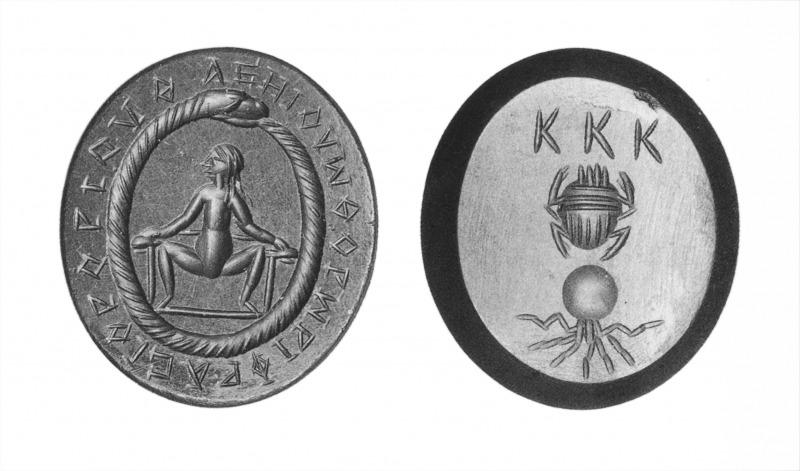Bonner, SMA, 276.
vowels in various combinations, also Iao at r., Sabaoth at bottom. Outside ouroboros, the Soroor formula, partly illegible through abrasion.
Rev. Ouroboros enclosing inscription in eight lines: oρωριoυθ ιαη.. (four characters and Chnoubis symbol) ιαηωιεαι βoρβoρ παρ φoρφoρ βαρ φoρφoρ ραι.
Haematite. Upright oval, 20 X 18 X 3.
143
Obv. At r., ram-headed god (Chnum) with disk on head seated to l., holding in extended r. hand the uterine symbol with a tiny Harpocrates seated on it. At l., a female figure partly broken away, standing to r. and raising r. hand toward Harpocrates. A groove above her hand is an accidental scratch or chip. Above, the seven vowels; in exergue, ραλθεμιθ (cf. the last word in the reverse inscription of 139).
Rev. Inscription in seven lines, damaged at r.: ιαιαιαηιηι Iαωwσαβαω αωvαι (five characters and an imperfect Chnoubis symbol) σoooρooρωριoυθ. The Soroor formula is abbreviated here, just as similar ones are mentioned by their first three or four syllables in magical papyri.
Haematite. Upright oval, 18 X 11 X 3.
144
Obv. Inscription in the form of a pterygoma, the first line repeated minus its first letter, the second and succeeding lines similarly treated, and so on until only the last letter remains: διψὰς Tάvταλε, αἷμα πίε, “Tantalus-viper, drink blood.” At lower l., warrior (Ares?) standing to front, head to l.; he is dressed in crested helmet, kilted tunic, chlamys and boots, r. hand holding spear upright, l. steadying shield which rests on the ground. Above the spearhead is a stylized thunderbolt. The first line of the pterygoma is too long for the space, and the last three syllables are written above the middle of the rest of the phrase.
Rev. Altar of peculiar form, over which is a uterine symbol, mouth upward. Above it, an eight-spoked wheel, at each side, a snake, its head near the edge of the symbol. At l., reading down, μεαθαδωα, at r., voει Σαβαωθ, on base of altar, Iαω, in exergue, the seven vowels. Adventitious scratches at left of altar base.
Haematite. Upright oblong with rounded corners, 54 Χ 29 Χ 6.5. The illustrations are from direct photographs, which I owe to the courtesy of Mr. Henri Seyrig, who published the amulet in Berytus, I, 3–4. For full discussion of the interpretation see p. 88.
145
Obv. Ouroboros enclosing naked woman seated with knees apart in wide chair, her hands gripping the arms. Head to l., hair loose. Round margin, outside ouroboros, αεηιoυωθ oρωριφρασι oρoριoυθ. The inscription is noteworthy as combining a corruption of Aroriphrasis (a secret name of Aphrodite) with the name of the guardian of the womb, Ororiouth.
Rev. Above, KKK, center, scarab, below, round body with seven wavy lines projecting from its bottom. Another form of the uterine symbol (cf. No. 139). The three kappas are found on the reverse of colic amulets, where the obverse shows Herakles and the lion; see Nos. 108–110 and 146.
Red jasper in gold ring. Upright oval, 18 X 16.
146
Obv. Herakles to l., throttling lion, club behind; enclosed by ouroboros. Lower half of design lost.
Rev. Woman with loose hair; in squatting position, knees wide open showing tense, swollen abdomen; sword brandished in r. hand. Uncertain cuttings at each side of feet may possibly have been parts of the ligaments of the uterine symbol placed in the lower part. A squatting woman is placed over that symbol in a stone of the Ayvaz collection published by Mouterde; not one of those purchased by the University of Michigan. See Mélanges Univ. St.-Joseph 25, 119; No. 40, Pl. 8. In field
Last modified: 2012-11-09 11:04:07
Link: cbd.mfab.hu/pandecta/1723




